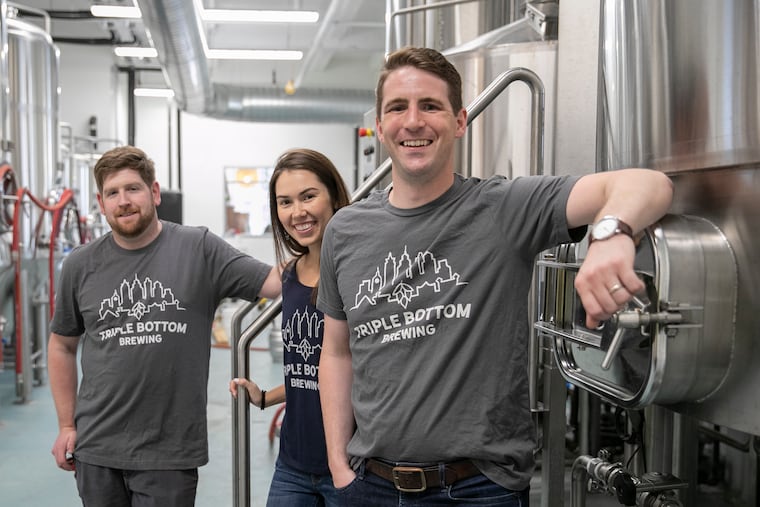Why Triple Bottom is serving more than just beer
"We’re doing it all through craft beer because we see these spaces as places where people gather and also places where people want to learn."

If it seems as if a new brewery pops up every day, that’s not even close. The Brewers Association, which focuses on independent craft breweries, counted 7,346 in the United States last year, compared with 3,814 just four years before. That’s more than two new small breweries a day.
All hew to the bottom line, but Philadelphia’s Triple Bottom Brewing, which opened earlier this month at 915 Spring Garden St., in a booming part of town, respects what owners Tess Hart; her husband, Bill Popwell; and brewmaster Kyle Carney call the “triple bottom line” — the impact on beer, people, and the planet.
In sum, they’re trying to deliver tasty beer, employ a cross-section of people, and respect the environment.
I sat with Hart shortly before the opening.
Can you give me the elevator pitch?
We are a craft brewery with a social mission. We’re a fair-chance business, which means that our team comes from a wide variety of diverse backgrounds and experiences. And we have three nonprofit partners who have actually helped us identify some of our team members: Project HOME, the Youth Sentencing and Reentry Project, and the Mural Arts Restorative Justice Program. We believe that beer brings people together and that breweries are places of community. We see that in all the breweries that we go to, and we wanted to work really hard to be very intentional here about how we were fostering and lifting up the community all around us and the diversity of that community. A big part of our hiring process has been driving toward: How do we lift up everyone and make sure that everyone in every community has the opportunity to craft something great? It’s been something that we’ve worked really hard on in this neighborhood, to get to know all of our neighbors, and host community meetings here, and make sure that this is a place that people know they are welcome.
We’re doing it all through craft beer because we see these spaces as places where people gather and also places where people want to learn. People come to a brewery looking for a story, not just a drink, and that sparks an open-mindedness and curiosity, and people start looking for the story in each other a little bit. What a great platform to then tell a story about all the wonderful things that are happening in our community and the ways that a business can serve that.
How did this start?
It started with my husband and myself both working in community development in Washington, D.C., and getting very into going into craft breweries. We love beer but we’re not beer nerds. We’re not going to stand in line for the can release.
We were trying to figure out what it was about craft breweries that really attracted us. When we travel, that’s where we want to go because that’s how we would get to know the neighborhood. That’s where we would meet people. And, we started noticing that people were making connections there that they weren’t making anywhere else.
We started noticing how vibrant they were as community gathering places. There’s so many different ways that a brewery can both engage with its community and provide opportunities to its employees, because there’s manufacturing, there’s customer service. We started thinking about how we could bring together our backgrounds in community development with this type of business that we were really falling in love with and we saw this great opportunity with.
We met Kyle through the internet after we had started to formulate this plan and what we wanted to achieve with it. He’s a Bucks County native but had been in San Diego at Stone Brewing Co. for five years. He was coming home and looking for something new. The three of us, about three years ago now, embarked on this thing together.
After your community meetings, how did you modify any of your ideas?
Making sure that we had a good selection of nonalcoholic drinks. Not everyone wants a beer, so taking requests for what type of soda people want. This space in the back can be a private space. There’s a big sliding door ... privacy in community meetings sometimes is important. We gathered ideas for types of events that we could have here. People may know a musician that could play, or people want to have bingo nights here, and really listening to how this space can be used by our neighbors, as well.
How did you find the location?
It was quite a journey. There’s the practical considerations that we need: high enough ceilings to have our tanks in, that we are planning to have most of our sales be in our taproom, so we needed to be in a place that was visible and accessible by lots of ways of transit. But, we also were catering to two diverging communities.
We’re catering to the millennial crowd who loves craft beer and we’re catering to people who are overlooked and underserved in the part of Philadelphia that’s really experiencing deep poverty. And so we wanted to find a place that was on the bridge of both of those and looked at a lot of different places and are really excited about this because it meets all those, but also we’re right across from Roy-Pitz, and down the street from Yards and Love City.
So it’s also becoming a place where there’s a lot of collaboration and a lot of mutual benefit from people wanting to come have an experience in this neighborhood.